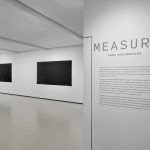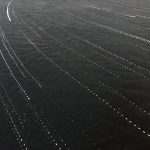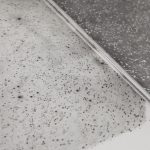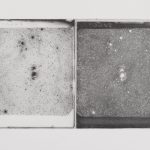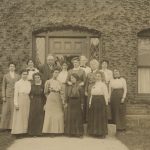MEASURE at the Radcliffe Institute, Harvard University, exhibition wall text:
Henrietta Leavitt, a century ago, worked at the Harvard College Observatory studying glass plate photographs of the night sky. Her aim was to determine the brightness of stars, gauging one star—one speck of emulsion—at a time. Her findings provided a tool to measure stellar distances. The shape of our galaxy was revealed, as were galaxies beyond our own.
In stitches and graphite, Anna Von Mertens reimagines Leavitt’s patient work. Her hand-stitched quilts bind together small, embodied gestures with vast ranges of space and time. The diptych on display traces the arc of stars across the sky at dawn on the day of Leavitt’s birth and at dusk on the day of her death—the span of Leavitt’s life held in between. Four quilts translate cosmological data, offering rotated perspectives on the gravitational boundary of our galactic supercluster: the largest known structure in the universe, and the farthest reach of Leavitt’s foundational work.
The drawing is a meticulous rendering of glass plates from the observatory. Leavitt stacked positive and negative plates to detect variable stars as tiny misalignments of dark and light. With repeated acts of observation, attention, and comparison, Von Mertens parallels Leavitt’s process. These small actions are units of understanding; Von Mertens seeks, along with Leavitt, to measure our place in space and time.
Video of Radcliffe Institute lecture
Opening essay for the book published in conjunction with the exhibition:
This exhibition is built on many units of measurement: the length of a single stitch, the density of lead in a 2H or 3H pencil, the distance a beam of light travels in a year, the brightness of a single star, the span of a life lived. Each unit alone holds something: the echo of its making, the marking of time, the beauty of its specificity. Each unit accumulated gains something; with repetition, form takes shape and shape takes meaning.
When I was invited to create an exhibition for the Radcliffe Institute, I began to explore the various archives on campus. At the Harvard College Observatory, I had the thrill of viewing the glass plate collection that is the world’s oldest and most comprehensive record of the stars. I learned about the women who studied these photographs of past nights’ skies. I was particularly captivated by the American astronomer and Harvard “computer” Henrietta Leavitt. Leavitt’s foundational work allowed us to measure stellar distances. She tracked changes in variable stars—stars that slowly pulse from bright to dim and bright again. Leavitt noticed a correlation between the length of time it took a star to pulse and how bright that star actually was. Once Leavitt demonstrated this relationship, the duration of a variable star’s pulse was all astronomers needed to calculate the distance to that star. As subsequent variables were identified and their locations established, a picture of the space around us emerged. We suddenly knew where we were.
Henrietta Leavitt accomplished all this by sitting and looking; she committed her time to the study of these glass plates. I think objects can absorb time, absorb our physical presence. That is why I make detailed drawings; that is why I sew quilts by hand. Historically, quilts have been objects that carry stories through time. They connect generations and allow silent voices to be heard. The act of hand stitching—holding layers together, holding ideas together—makes my objects solid. They become sturdy enough to carry an idea. With my commitment of time, I hope to help carry Henrietta Leavitt’s story.
The stars fading from view on the morning of Henrietta Leavitt’s birth, July 4, 1868, Lancaster, Massachusetts; The stars returning into view on the evening of Henrietta Leavitt’s death, December 12, 1921, Cambridge, Massachusetts, 2018, hand-stitched cotton, 54 x 100 in. (each)
I made a diptych of two hand-sewn quilts in tribute to Henrietta Leavitt’s life—her devotion to looking and seeing, the understanding her discoveries facilitated, the fact that she died before that meaning was fully revealed. I stitched the star trails spanning the first hours of dawn on the morning of her birth and again as dusk settled on the evening of her death. Time continuing backwards, time continuing forward, a reverse bracket of light.
Henrietta Leavitt devised systems to determine the brightness of stars. This included comparing a star from plate to plate, accounting for exposure conditions and the particulars of the emulsion of each photograph, writing averages in her logbooks — and simply looking, while simultaneously having an awareness of the limitations and tendencies behind that looking. Through all this, Leavitt determined the magnitude of a single star.
I, too, needed a system. Using software to calculate the stars of the past, I projected the stars that framed Leavitt’s birth and death onto fabric. To play time forward required a choreography. Walking back and forth between my computer and the projection, I traced the trajectory of each star with chalk, each star becoming a wobbly line. I reset the time and started again—another star, another arc of chalk. I assigned each star a value based on its brightness and linked that value to a corresponding thread color. Then, disappearing through the grayscale, I faded each line into the black background by switching thread colors every few inches as I sewed.
Henrietta Leavitt sat and calculated; I sat and stitched. We devised systems for seeing. In the end, our systems receded. What remained was the brightness of stars. What remained were sewn trails of stars curved against the domed memory of the sky.
Thinking about installing this diptych—a scene at dawn, a scene at dusk—what should the distance between the works be? Does a connection pull them closer, or does the life lived within that space push them farther apart? These curtains of time pulled back—what is held in the space in between?
Shape/View series (View I & View V as examples shown in the slide show above), hand-stitched cotton, dimensions variable
I have always been anxious about new spaces. When I was little, I would send my brother to find the bathroom in a restaurant and report back. I would find my way using his instructions. Without a map to build the space around me, I feel uncertain, on guard. My anxiety clouds my ability to see. With a sense of place, I settle in and open my eyes.
My work revolves around mapping. The first quilts I made mapped the topography of my own body in thread and explored how the site of the bed defines a sense of home. Next, I diagrammed energy dispersion patterns on cellular and cosmological levels: how energy is used, stored, and regenerated—a mapping of forces and flows. Then I turned my gaze to the heavens, an age-old way to find one’s bearings. The stars orient us, guide us, and in our attempts to understand them, remind us that what we believe shapes what we see. The heavens, after all, reveal to us that we are not at the center—of our solar system, of our galaxy, of our universe. With that perspective, we see more clearly where we are physically, internally.
Henrietta Leavitt provided a unit of measurement that reached far out into the universe, stretching the known size of the cosmos and shaping the universe as it reached. When I learned about her life and work here at Harvard, to my surprise, I found an origin story, a beginning for the vast distances that have long structured my work. Henrietta Leavitt is the reason I feel at home.
My series Shape/View, completed just before this project began, pushes outwards—indeed, to the largest known structure of the cosmos. The stark black silhouettes of these works are determined by the gravitational boundary of our galaxy’s supercluster. Each work shows our supercluster from a different point of view, prompting a sense of holding an object in one’s hand, turning and examining it. This new astrophysical form—the galactic supercluster—was determined by recent calculations. The universe is expanding, but discounting that cosmic expansion to highlight the pull from different basins of attraction, scientists have been able to map which galaxies are flowing toward us and which galaxies are pulling away. Our supercluster, an organization of 100,000 galaxies, is defined by where that flow diverges—a cosmic watershed.
As my imagination reached out into the heavens I returned to a human scale and the physical body. I translated this immense volume of data—this unimaginable expanse of space—into a simple gesture drawing in chalk, then built it up stitch by stitch.
Negative and Positive Plates B20667 and D16409, Nebula in Orion, Oct 26, 1897, 2018, pencil on paper, drawing: 15 x 24 in., paper: 22 x 30 in.
In honor of the time spent sitting and looking by the women of the Harvard College Observatory, I sat at my desk drawing two glass plates, one positive and one negative—inverse images of the same photograph. Both plates depicted the Orion Nebula, a cloud of gas and dust where stars are formed, a birthplace of stars. Henrietta Leavitt looked there to find variable stars—stars that would become her beacons of measurement.
Leavitt imposed a grid onto the photographic plate to establish guidelines among the emulsion specks of stars. I sought the same guidance. I penciled out a network of fine lines, sketching the brightest stars within them as markers. At first I panicked; my system wasn’t working. On the left side, the grid stood out too strongly against the negative photograph’s light background; it might dominate the drawing. On the right side, given the positive’s dark background, the darkness I laid down in graphite would erase the grid. I would become lost as I drew. Slowly, I realized the grid was there to hold me. It would disappear when it was no longer needed, or a trace of it would remain. The drawing would be whatever it was to be. I would find my way.
Determining points within a grid is akin to plotting coordinates on a map. But it is a creative endeavor, not a foregone conclusion. Forming these stars, shaped like kernels of rice or grains of sand, required caretaking: a slow determining, locating, encircling, losing, defining, herding. These shapes of light held my attention.
Henrietta Leavitt gave attention. She gauged the brightness of stars. From this quiet act of observation, elaborate in its simplicity and complexity, we are able to measure the universe.
There is satisfaction in this narrative arc of history, a validation that Leavitt’s work lives on in the ways it deepens our understanding and shifts our awareness. But there is also a sense of loss. Did Leavitt feel validated in her work? What meaning is contained within her lifetime?
Together we draw a line, imagined and real, between one life, one gesture and the ocean that swallows us whole. A simple action—a stitch, a mark, a calculation, a measurement—and its repetition, require faith. That faith lies in the other meaning of “measure” as a plan or course of action taken towards a particular purpose. But what our measurements will accomplish we cannot fully know. Through our small actions we move, perhaps getting a glimpse of where we are headed.














